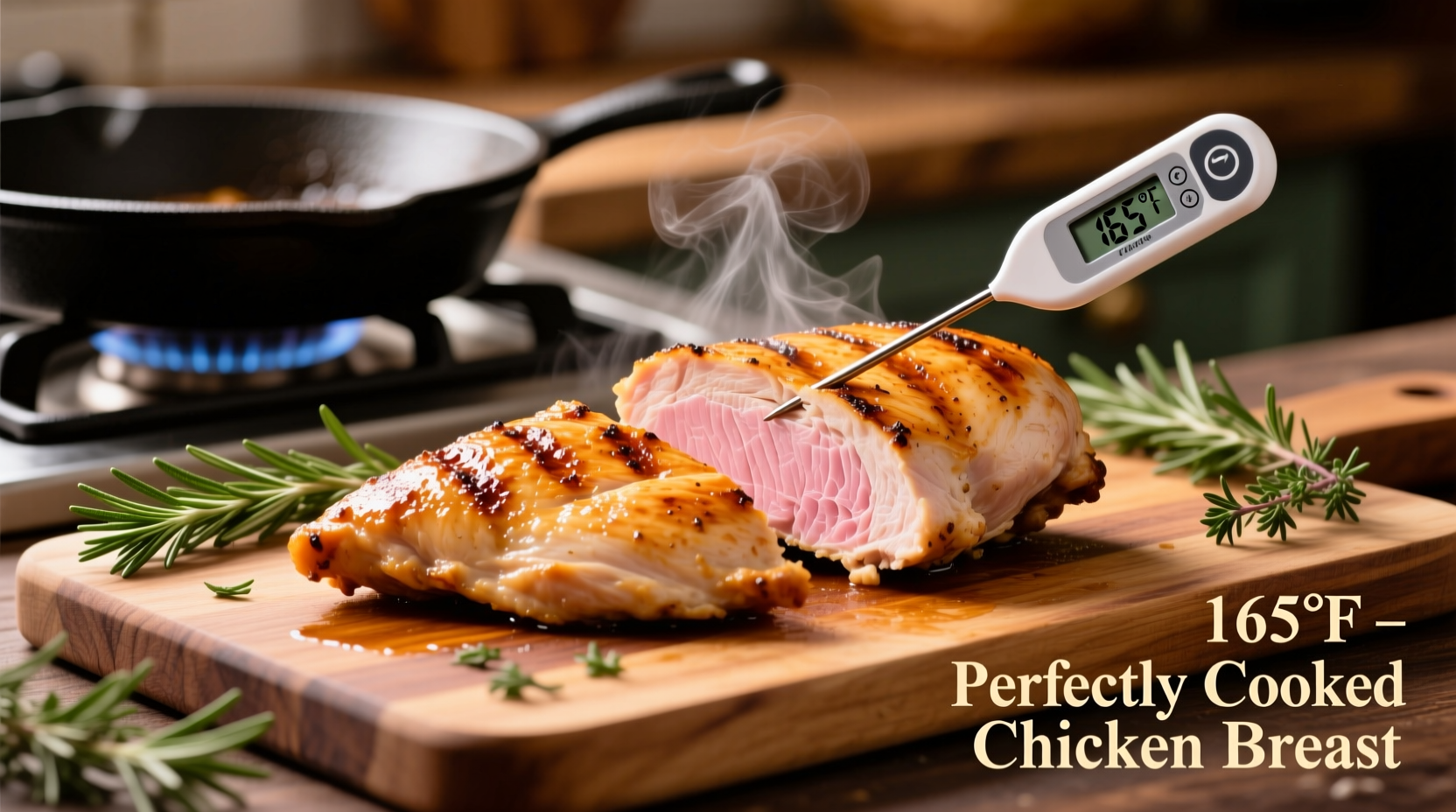The safe internal temperature for cooked chicken breast is 165°F (73.9°C) according to USDA Food Safety and Inspection Service guidelines. This temperature destroys harmful bacteria like salmonella while ensuring safe consumption. Use an instant-read thermometer for accuracy—never rely solely on visual cues.
Why Chicken Breast Temperature Matters More Than You Think
Getting chicken breast temperature right isn't just about safety—it's the difference between juicy perfection and dry disappointment. While 165°F (73.9°C) is the USDA's minimum safe temperature, food science reveals why this number alone doesn't tell the whole story.
The Science Behind Safe Chicken Cooking
Salmonella and other pathogens in poultry are destroyed instantly at 165°F (73.9°C). But here's what most cooking resources don't explain: proteins in chicken begin denaturing at just 140°F (60°C), causing moisture loss that accelerates as temperature rises. This explains why chicken breast becomes dry when cooked beyond 165°F.
| Temperature | Protein Reaction | Texture Result | Food Safety Status |
|---|---|---|---|
| 140°F (60°C) | Initial protein denaturation begins | Translucent appearance | Unsafe - bacteria still active |
| 150°F (65.6°C) | Significant moisture loss begins | Pinkish hue, slightly firm | Unsafe - requires sustained time |
| 160°F (71.1°C) | Rapid moisture expulsion | Firm texture developing | Marginally safe with 15+ seconds hold |
| 165°F (73.9°C) | Complete pathogen destruction | White, firm, safe | Instantly safe per USDA |
| 170°F+ (76.7°C+) | Maximum moisture loss | Dry, stringy, overcooked | Safe but compromised quality |
How to Measure Chicken Temperature Correctly
Many home cooks measure chicken temperature incorrectly, leading to either unsafe food or dry results. Follow these professional techniques:
- Thermometer placement: Insert into the thickest part of the breast, avoiding bone or fat pockets
- Multiple check points: Check 2-3 different spots as chicken cooks unevenly
- Timing matters: Wait 3-5 seconds for digital thermometers to stabilize
- Calibration check: Test thermometer in ice water (should read 32°F/0°C) before use

Carryover Cooking: The Secret Professional Chefs Use
Chicken continues cooking after removal from heat due to residual heat—a phenomenon called carryover cooking. This explains why you should remove chicken breast at 157-160°F (69.3-71.1°C), allowing it to reach 165°F during resting.
Resting time significantly impacts final texture:
- Smaller cuts (4-6 oz): 5 minutes resting
- Standard boneless breasts: 8-10 minutes resting
- Thick or bone-in breasts: 12-15 minutes resting
Cooking Method Matters: Temperature Adjustments by Technique
While the target internal temperature remains constant, your cooking approach affects how you reach it:
Pan-Searing
Cook over medium-high heat until golden brown (3-4 minutes per side), then reduce heat and cook to 157°F before resting. The sear creates flavorful Maillard reactions while controlled heat prevents overcooking.
Baking
Preheat oven to 400°F (204°C) for faster cooking that minimizes moisture loss. Bake until internal temperature reaches 157°F, typically 18-22 minutes depending on thickness. Higher heat reduces cooking time, preserving juiciness.
Grilling
Use two-zone cooking: sear over direct heat, then move to indirect heat until reaching 157°F. This prevents exterior charring before interior reaches safe temperature.
Avoid These Common Temperature Mistakes
Even experienced cooks make these critical errors that compromise safety or quality:
- Visual-only doneness testing: Color isn't reliable—chicken can appear done at 150°F but remain unsafe
- Single-point temperature check: Thick breasts cook unevenly; always check multiple spots
- Ignoring carryover cooking: Removing at 165°F guarantees overcooked, dry results
- Not calibrating thermometers: Uncalibrated thermometers can be off by 5-10°F
Food Safety Timeline: How Chicken Temperature Guidelines Evolved
Chicken safety standards have evolved significantly based on improved food science research:
- 1970s: Recommended cooking to 180°F based on limited pathogen research
- 1990s: USDA lowered recommendation to 170°F as testing methods improved
- 2006: Current standard of 165°F established with precise pathogen kill data
- Present: Some chefs advocate for 150°F with 3.7-minute hold for premium texture (not recommended for home cooks)
These changes reflect better understanding of bacterial destruction kinetics. The USDA maintains 165°F as the practical standard because it requires no timing calculations—reaching this temperature instantly ensures safety.
When Visual Cues Can Supplement Temperature Checks
While thermometers are essential, these secondary indicators confirm proper cooking:
- Juices run clear, not pink
- Firm but springy texture when pressed
- No translucent appearance in thickest section
However, never rely solely on these methods. The USDA confirms that color alone cannot reliably indicate safety, as factors like marinades or cooking methods affect appearance.
Special Considerations for Different Situations
Certain cooking scenarios require temperature adjustments:
- Brined chicken: May appear done at lower temperatures due to protein changes
- Stuffed breasts: Must reach 165°F in both chicken and stuffing
- Slow cooking: Requires maintaining 140°F+ for extended periods to ensure safety
- Leftovers: Reheat to 165°F minimum for safe consumption
For vulnerable populations (pregnant women, elderly, immunocompromised), strict adherence to 165°F is particularly important as their risk from foodborne illness increases significantly.











 浙公网安备
33010002000092号
浙公网安备
33010002000092号 浙B2-20120091-4
浙B2-20120091-4